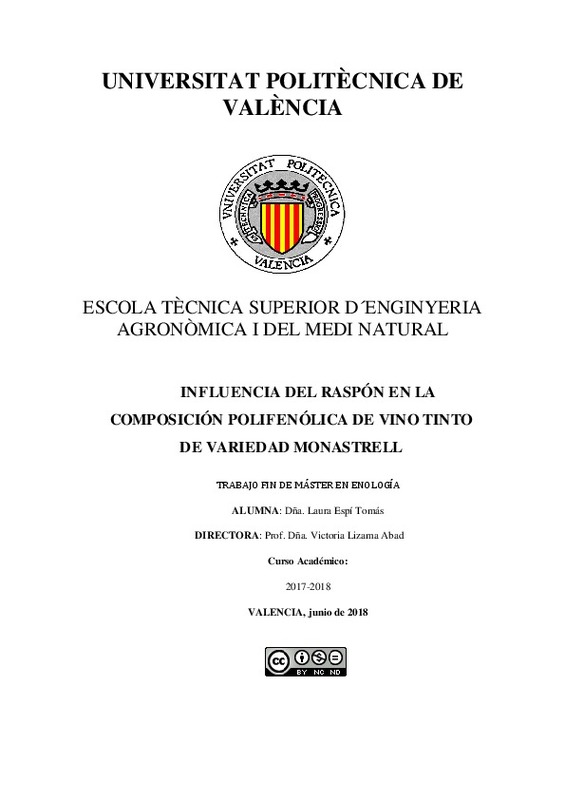JavaScript is disabled for your browser. Some features of this site may not work without it.
Buscar en RiuNet
Listar
Mi cuenta
Estadísticas
Ayuda RiuNet
Admin. UPV
Influencia del raspón en la composición polifenólica de vino tinto de variedad monastrell
Mostrar el registro sencillo del ítem
Ficheros en el ítem
| dc.contributor.advisor | Lizama Abad, Victoria
|
es_ES |
| dc.contributor.author | Espí Tomás, Laura
|
es_ES |
| dc.date.accessioned | 2018-09-12T17:12:31Z | |
| dc.date.available | 2018-09-12T17:12:31Z | |
| dc.date.created | 2018-07-06 | |
| dc.date.issued | 2018-09-12 | es_ES |
| dc.identifier.uri | http://hdl.handle.net/10251/107179 | |
| dc.description.abstract | [ES] El empleo de una fracción de racimo entero en vinificación, incluyendo el raspón o escobajo, se trata de una técnica a la que se han sumado muchos elaboradores de vino tinto durante los últimos años, frente a un despalillado generalizado y ampliamente justificado en la bibliografía enológica. Con el objetivo de evaluar la influencia que este porcentaje de raspón tiene en la composición final del vino se llevaron a cabo tres micro-vinificaciones simultáneas con uva tinta de variedad Monastrell. Se maceró por una parte uva despalillada (0%), por otra parte 20% de racimo entero con un 80% de uva despalillada (20%), y por último 60% de racimo entero con 40% de uva despalillada (60%). Se analizaron tanto las propiedades convencionales como la composición polifenólica de los diferentes vinos. Los resultados muestran que el vino macerado con 60% de raspón fue el más diferente del resto. Resultó con un pH más elevado que las otras dos muestras. La concentración de polifenoles, de taninos totales y de taninos condensados fue también superior, lo cual se asoció a la composición del raspón, que liberaría estos compuestos en maceración. El grado alcohólico, la Intensidad Colorante y la concentración de antocianos libres fue menor en ambas muestras maceradas con raspón (20% y 60%), lo cual se asoció a una fijación a la estructura del raspón del alcohol y los antocianos libres. El grado de polimerización de los taninos así como las combinaciones antociano-tanino no se vieron afectadas por la presencia de raspón, pero puesto que estas combinaciones y polimerizaciones dependen de otros factores como el tiempo, se debería observar su evolución tras un periodo de crianza en botella. | es_ES |
| dc.description.abstract | [EN] The utilisation of a percentage of whole cluster in winemaking, including the stem, is a technique that many wine-makers have joined in recent years, instead of using the generalised destemming technique, which has been widely justified in the oenological bibliography. With the aim of evaluating the influence that this percentage of stem has in the final composition of wine, three simultaneous micro-vinifications, with the grape variety Monastrell were carried out. The sample called 0% was macerated with 100% of destemmed grapes, the sample called 20% was macerated with 20% of whole cluster and 80% of destemmed grapes, and the sample called 60% was macerated with 60% of whole cluster and 40% of destemmed grapes. Both conventional parameters and phenolic composition were analysed. The results showed that the sample of wine macerated with 60% of stem was the most different one. It turned out with a higher pH than the two other samples. The concentration of polyphenols, total tannins and condensed tannins were also higher, which was associated to the composition of the stem that releases this compounds during maceration. Alcoholic degree, Colour Intensity and the concentration of total anthocyanins were lower in both samples that were macerated with stems (20% and 60%), which was associated to a fixation of alcohol and anthocyanins to the stem s structure. The degree of polymerisation of tannins as well as the combinations anthocyanins-tannins were not affected by the presence of stem, but due to this combinations and polymerisations depend on other factors like time, an evaluation of the evolution during aging in bottle should be carried out. | es_ES |
| dc.format.extent | 32 | es_ES |
| dc.language | Español | es_ES |
| dc.publisher | Universitat Politècnica de València | es_ES |
| dc.rights | Reserva de todos los derechos | es_ES |
| dc.subject | Raspón; Vinificación; Vino tinto; Monastrell; Caracterización; Polifenoles | es_ES |
| dc.subject | Stem;Vinification; Red wine; Monastrell; Characterisation; Polyphenols | es_ES |
| dc.subject.classification | TECNOLOGIA DE ALIMENTOS | es_ES |
| dc.subject.other | Máster Universitario en Enología-Màster Universitari en Enologia | es_ES |
| dc.title | Influencia del raspón en la composición polifenólica de vino tinto de variedad monastrell | es_ES |
| dc.type | Tesis de máster | es_ES |
| dc.rights.accessRights | Abierto | es_ES |
| dc.contributor.affiliation | Universitat Politècnica de València. Departamento de Tecnología de Alimentos - Departament de Tecnologia d'Aliments | es_ES |
| dc.contributor.affiliation | Universitat Politècnica de València. Escuela Técnica Superior de Ingeniería Agronómica y del Medio Natural - Escola Tècnica Superior d'Enginyeria Agronòmica i del Medi Natural | es_ES |
| dc.description.bibliographicCitation | Espí Tomás, L. (2018). Influencia del raspón en la composición polifenólica de vino tinto de variedad monastrell. Universitat Politècnica de València. http://hdl.handle.net/10251/107179 | es_ES |
| dc.description.accrualMethod | TFGM | es_ES |
| dc.relation.pasarela | TFGM\92710 | es_ES |
Este ítem aparece en la(s) siguiente(s) colección(ones)
-
ETSIAMN - Trabajos académicos [3543]
Escuela Técnica Superior de Ingeniería Agronómica y del Medio Natural






